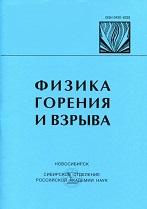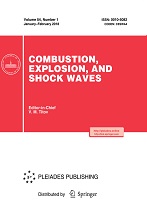|
This article is cited in 6 scientific papers (total in 6 papers)
Modeling of ignition and combustion of a cocurrent hydrogen jet in a supersonic air flow
O. S. Vankova, N. N. Fedorova
Khristianovich Institute of Theoretical and Applied Mechanics, Siberian Branch of the Russian Academy of Sciences, 630090, Novosibirsk, Russia
Abstract:
Results of a numerical study of mixing, ignition, and combustion of a cold hydrogen jet propagating along the lower wall of a channel parallel to a supersonic $(\mathrm{M} = 2)$ flow of an inert gas mixture/wet hot air are reported. The computations are performed with the use of the ANSYS CFD Fluent commercial software by means of solving unsteady Favre-averaged Navier–Stokes equations supplemented with the $k{-}\omega$ SST turbulence model and several kinetic schemes of hydrogen combustion. Two brutto schemes and three detailed kinetic schemes including $16$, $38$, and $37$ direct and reverse reactions are considered. The goal of the study is to choose a computation method and kinetic mechanism that ensure good agreement with experimental data on supersonic combustion of a cocurrent hydrogen jet. In the case of a non-reacting flow, it is demonstrated that the computational algorithm can accurately predict the parameters of mixing of the hydrogen jet and external flow. In the case of a reacting flow, the flow characteristics are significantly affected by large vortex structures developing at the boundary of the combustion layer with the external flow. If the flow unsteadiness is taken into account and a detailed kinetic scheme with $37$ reactions is used, good agreement of the mean characteristics of the flow with experimental data on the distributions of pressure, temperature, Mach number, and species concentrations at the combustor exit is provided.
Keywords:
supersonic combustor, mixing of air with hydrogen.
Received: 29.06.2020
Revised: 10.07.2020
Accepted: 22.07.2020
Citation:
O. S. Vankova, N. N. Fedorova, “Modeling of ignition and combustion of a cocurrent hydrogen jet in a supersonic air flow”, Fizika Goreniya i Vzryva, 57:4 (2021), 18–28; Combustion, Explosion and Shock Waves, 57:4 (2021), 398–407
Linking options:
https://www.mathnet.ru/eng/fgv773 https://www.mathnet.ru/eng/fgv/v57/i4/p18
|


| Statistics & downloads: |
| Abstract page: | 27 |
|





 Contact us:
Contact us: Terms of Use
Terms of Use
 Registration to the website
Registration to the website Logotypes
Logotypes








 Citation in format
Citation in format 
